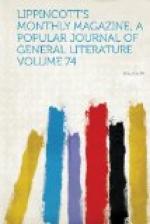In 1666 the Great Fire of London burnt its way westward as far as the Temple. After consuming several sets of chambers and a quantity of title-deeds to many valuable estates, the course of the flames was stayed just east of the Temple Church. But in 1678-79, in the mouth of January, a large area was burned over. The fire lasted from midnight till noon of the ensuing day. Pump Court, Vine Court, part of Brick Court, Elm-Tree Court, Hare Court, part of Middle Temple Hall, a portion of Inner Temple Hall, and the old cloisters, were swept away. The season was remarkable for its severity: the Thames was frozen over, and the supply of water entirely inadequate. So great hogsheads of ale were hoisted up from the cellars and the liquor fed to the clumsy hand-engines of the period. When the ale gave out, recourse was had to gunpowder,—buildings in the track of the flames being blown up; but in this dangerous work the Temple library was demolished. In the end, however, the Temple was the gainer by this fire: much better structures took the place of the old rookeries, and the entire precinct was purified.
Around the hoary walls of the Temple cluster memories of many a strange custom or quaint observance. The revels at Yule-tide, St. Stephen’s Day, New Year’s Day, and Twelfth Night were not surpassed anywhere in “merrie England.” Feasts, masques, and play-acting at various times greatly scandalized the more sober and staid among the benchers. Stowe tells us that the readers of his day “for upwards of three weeks kept a splendid table, feasting the nobility, judges, bishops, principal officers of state, and sometimes the king himself, insomuch that it has cost a reader above one thousand pounds,”—a mint of money in those frugal days. Revelries grew in frequency and attractiveness as the business of instruction declined, so much so that we are compelled to believe that at one period the qualifications for admission were merely nominal. A banquet given by Sir Heneage Finch the year following the restoration of Charles II. lasted from the 4th to the 17th of August, and all London was invited and made welcome.
In one point the Templars of to-day are not a whit behind their predecessors: they give good dinners. For centuries the benchers of the two societies have dined in each other’s company once a year in the great hall; and to Mr. Thornbury we are indebted for the following description of a Temple dinner of to-day:
“An Inner Temple banquet is a very grand thing. At five or half-past five the barristers and students in their gowns follow the benchers in procession to the dais; the steward strikes the table solemnly a mystic three times; grace is said by the treasurer or senior bencher present, and the men of law fall to. In former times it was the custom to blow a horn in every court to announce the meal. The benchers observe somewhat more style at their table than the other members do at theirs. The general




